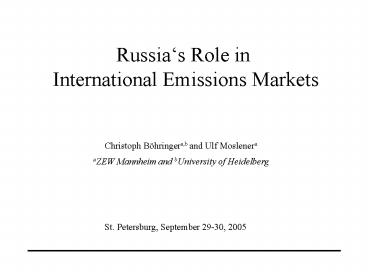PowerPointPrsentation - PowerPoint PPT Presentation
1 / 21
Title:
PowerPointPrsentation
Description:
Christoph B hringera,b and Ulf Moslenera. aZEW Mannheim and bUniversity of Heidelberg ... and regional compliance cost depend crucially on Russia s rationing of Hot ... – PowerPoint PPT presentation
Number of Views:25
Avg rating:3.0/5.0
Title: PowerPointPrsentation
1
Christoph Böhringera,b and Ulf Moslenera aZEW
Mannheim and bUniversity of Heidelberg
St. Petersburg, September 29-30, 2005
2
Overview
- 1. Policy Issues
- 2. Analytical Framework
- 3. Simulation Results
- 4. Conclusions
3
- 1. Policy Issues
- 2. Analytical Framework
- 3. Simulation Results
- 4. Conclusions
4
International Climate Policy
World
United Nations Framework Convention on Climate
Change (1992)
- Kyoto-Protocol (1997)
- QELROs for industrialized countries (2008-2012
vs. 1990) - Flexible mechanisms (cost efficiency)
- IET International Emissions Trading (ET
between Annex B countries) - JI Joint Implementation (project-based ET
between Annex B countries) - CDM Clean Development Mechanism (project-based
ET with developing countries) - Entering into force as from 15.2.2005 (after
Russias signature)
Europe
- EU commitment under Kyoto minus 8 (bubble)
- EU Burden Sharing Agreement (1999) national
emission budgets - EU Emissions Trading System (ETS) for
energy-intensive industries - EU-ETS Directive (2003)
- Entering into force as from 1.1.2005
- DIR sectors (covered by ETS)
- NDIR sectors (outside ETS)
5
Multiple Emission Markets
Rest of Kyoto
European Union
DIR
- Russia (Hot Air)
- Ukraine (Hot Air)
- Japan
- Canada
Firms
NDIR
Governments
Governments
- One EU-ETS market between DIR sectors
- Complementary regulation in NDIR sectors for
each EU Member State - Comprehensive Kyoto market
6
Issue Compliance Cost and Environmental
Effectiveness
Policy dimensions
- Linkages of emissions markets
- Strategic behavior of Russia (rationing of Hot
Air)
Policy scenarios
7
- 1. Policy Issues
- 2. Analytical Framework
- 3. Simulation Results
- 4. Conclusions
8
Marginal Abatement Cost Curves
Reduced form representation
- Direct compliance (abatement) cost
- No indirect (general equilibrium) effects such
as changes in terms of trade
Graphical illustration Effective demand and
monopoly supply
C (/t)
JPN
C (/t)
CAN
75
300
D
CXSU
50
200
EUR
I
25
100
H
MRXSU
100
200
150
100
50
300
400
abatement(Mt C)
abatement(Mt C)
9
Algebraic Model (1) Competitive Setting
Competitive emission trading
First-order condition
Aggregate fringe import demand (i ? F)
10
Algebraic Model (2) Monopolistic Supply
Monopolistic permit supply (m)
First-order condition
11
Model Implementation (1) Parameterization of MACs
Least-square approximation
Discrete observations of (p, q)
- Current implementation top-down (PACE/GTAP)
- Alternative options bottom-up (POLES, PRIMES,
etc.)
12
Model Implementation (2) Regions and Sectors
Regions
- EU EU-14 (separated), Hungary, Poland, Rest of
Central European Associates - Other Kyoto parties Canada, Japan, Former Soviet
Union (Russia and Ukraine)
Sectors
- DIR energy-intensive sectors (as covered by
current EU-ETS) - NDIR remaining sectors of economy
13
Model Implementation (3) Benchmark Data
Carbon emissions and carbon reduction targets
14
- 1. Policy Issues
- 2. Analytical Framework
- 3. Simulation Results
- 4. Conclusions
15
Groups of Policy Scenarios
Group 1 Kyoto sine EU-ETS (covered in the
literature)
- NoTrade Diverging marginal abatement cost
(efficiency loss) - Kyoto-C Full supply of Russian Hot Air
- drives MACs down to zero (no compliance cost)
- makes emission constraint non-binding (no
environmental effect) - Kyoto Market power by Russia
- generates revenues for Russia
- positive MACs (compliance cost) and
environmental effect
Group 2 Kyoto cum EU-ETS (all with Russian
market power)
- EU-Closed Intra-EU implementation of Kyoto
targets (EU-ETS for DIR sectors and Kyoto
IET across EU Member States only) - EU-NDIR-Trade same as EU-Closed but EU Member
States use Kyoto IET on global market for
their NDIR sectors - EU-FSU same as EU-NDIR-Trade but Russia is part
of EU-ETS market
16
Results Kyoto sine EU-ETS
Compliance cost (in millions of )
Marginal abatement cost (in per ton of CO2)
17
Results Kyoto cum EU-ETS
Compliance cost (in millons of )
Note
- EU-Closed / EU-N-Trade Under the current
implementation of the EU-ETS, DIR sectors in
Europe are endowed with more emissions than
required for projected BaU emissions in 2005.
Total compliance costs are thus equal to
compliance costs of NDIR sectors. In scenario
EU-N-Trade Europe can lower the NDIR compliance
costs by linking this market to the Kyoto
market.
- EU-FSU Here, FSU engages in the EU-ETS and
behaves there as monopoly supplier. With the
current EU-ETS implementation, the MAC in the DIR
sectors of the EU-ETS would be zero and
thus EU-FSU would be equal in outcome to
EU-N-Trade. We therefore re-calibrated the
closed EU-ETS market to yield a CO2 price of 20
(by increasing uniformly the BaU emissions
within the DIR sectors).
18
Results Kyoto cum EU-ETS
Marginal abatement cost (in per ton of CO2)
Rationing of Hot Air
19
Results Environmental Effectiveness
Emission reduction (in from BaU)
Note Scenario EU-FSU is based on higher BaU
emissions for DIR-sectors in Europe.
20
- 1. Policy Issues
- 2. Analytical Framework
- 3. Simulation Results
- 4. Conclusions
21
Summary
- Russias role in international emissions markets
- Russian Hot Air supply is sufficient to make
Kyoto constraints non-binding - Market structure on different permit markets
matters - Linkages of permit markets matter
- Segmentation of the EU Emission Market under the
EU-ETS in principle allows Russia to exert
market power on two international markets.
- Global environmental effectiveness and regional
compliance cost depend crucially on Russias
rationing of Hot Air as monopoly supplier(The
monopolist is the environmentalists best
friend.).
- Russia benefits from the segmentation of EU
Emission Market as compared to uniform Kyoto
regime since it can exert monopoly power more
effectively.
- Towards more stringent emission constraints,
Russia may further benefit through additional
abatement (beyond sales of Hot Air).































